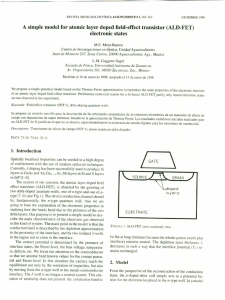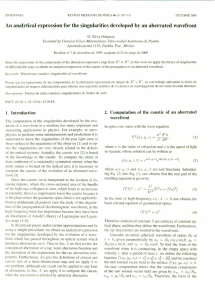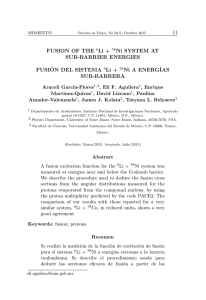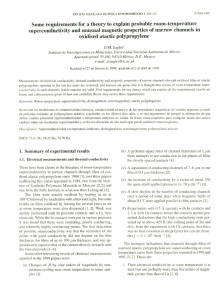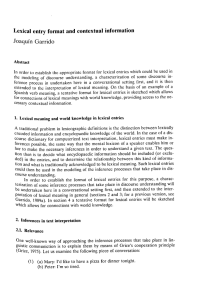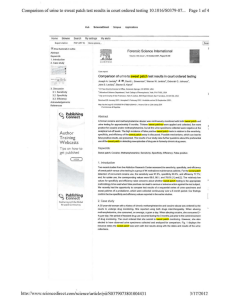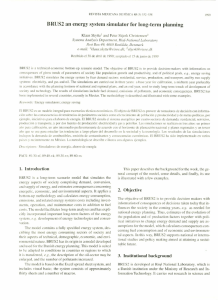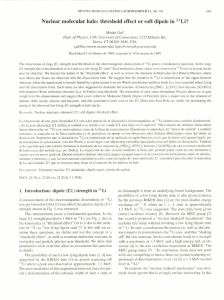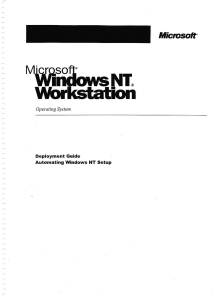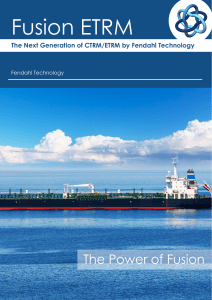Sub-barrier fusion of O + Ge systems
Anuncio
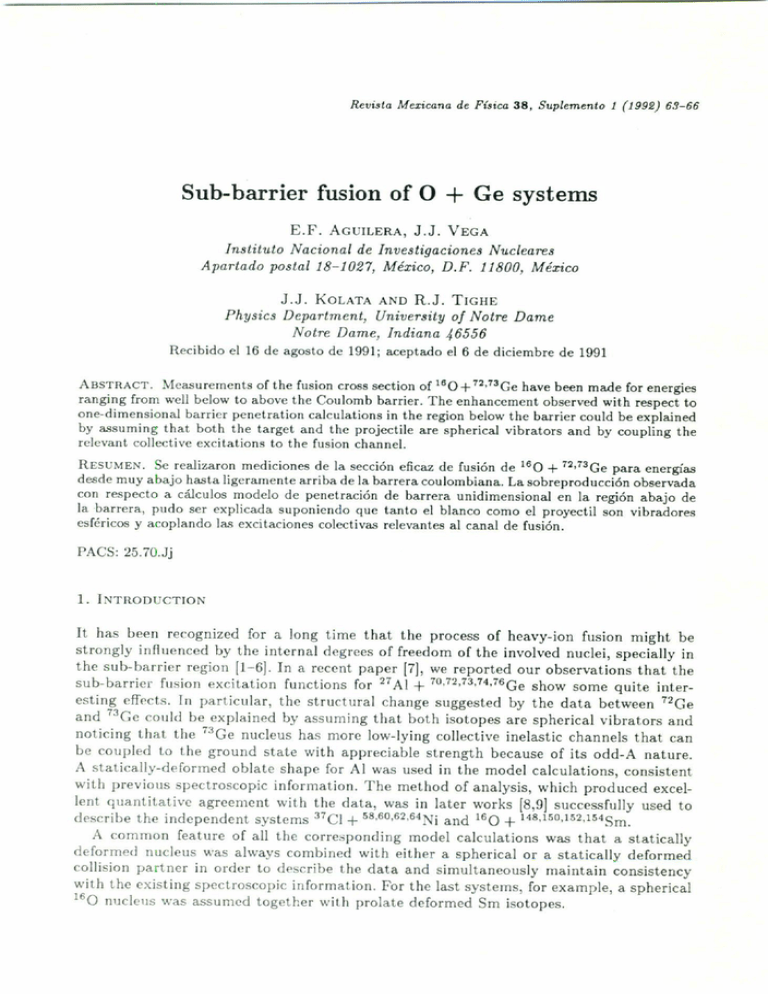
RevÚlta Mexicana de Fúica 38, Suplemento Sub-barrier fusion of O E.F. AGUILERA, J.J. + 1 (1992) 6."1-66 Ge systems VEGA Instituto Nacional de Investigaciones Nucleares Apartado postal 18-1027, México, D.F. 11800, México J.J. KOLATA AND R.J. TIGlIE Physics Department, University of Notre Dame Notre Dame, Indiana 46556 Recibido el 16 de agosto de 1991; aceplado el 6 de diciembre de 1991 ABSTRACT. 11casurernents of the fusion cross section of 160 + 12,73Ge have been made for energies ranging from wel! below lo aboye lhe Coulomb barrier. The enhancemenl observed wilh respecl lo ane-dimensional barrier penetration calculations in the region below the barrier could be explained by assuming thal bolh the largel and lhe projeclile are spherical vibralors and by coupling lhe rclevant collective excitations to the fusion channel. RESUMEN. Se realizaron mediciones de la sección eficaz de fusión de 160 + 72,73Ge para energías desde muy abajo hasta ligeramente arriba de la barrera coulombiana. La sobreproducción observada con respecto a cálculos modelo de penetración de barrera unidimensional en la región abajo de la barrera, pudo ser explicada suponiendo que tanto el blanco como el proyectil son vibradores esféricos y acoplando las excitaciones colectivas relevantes al canal de fusión. PACS: 25.70.Jj 1. [NTIWDUCTION It has been recognized for a long time that lhe process of heavy-ion fusion might be strongly inflllenced by the internal degrees of freedom of the involved nudei, specially in the sub-barrier region [1-6]. In a recent paper [7]' we reported our observations that the sub-barrier fusion excitation functions for 27Al 70.72.73,74.76Ceshow sorne quite interesting efTects. In particular, the struet tlfal change suggested by the data between 72Ce and 7JCe could be explained by assuming that both isotopes are spherical vibrators and noticing that the 73Ce nueleus has more low-Iying collective inelastic channe]s that can be eoup!ed to the ground state with appreciable strength because of its odd-A nature. A 5tatically-deformed oblate shape for Al was used in the mode! ca1culations, consistent with previous spectroscopic information. The method of analysis, which produced excel. lent '1uantitative agreernent wil h the data, was in later works [8,9) successfully used to describe the independent systems 37C1 + 58.60.62.64Niand 160 + 148.150.152.154Sm. A common feature of al! the corresponding model calculations was that a statically deformed nueleus \\'as always combined with either a spherical or a statically deformed col!ision partner in oreler to describe the data and simultaneously rnaintain consistency with the existing spectroscopic information. For the last systems, for example, a spherical 160 nl1del1S was assurned together with pral ate deformed Sm isotopes. + 64 E.F. AGUILERAET AL. With the double purpose of tinding independent evidenee for the mentioned struetural ehange in the Ge isotopes, on one hand, and testing the goodness of the model ealculations for the case of spherieal collision partners, on the other hand, we decided to investigate the 160 + 72,73Ge systems. In this paper we present sorne preliminary results of this investigation. In Section 2 the experimental proeedure and the eorresponding results are deseribed. Seetion 3 is devoted to discuss the data in terms of model ealculations and, tinally, the eonclusions of this work are presented in Section 4. 2. EXPERIMENTAL PROCEDURE AND RESULTS The 160 projectiles were obtained from the FN Tandem Van de Graaff aceelerator at the Vniversity of Notre Dame, The 72Ge target, 96.23% enriehed, was 565:J: 15 I'g/em2 thiek, while the thiekness of the 73Ge target (94.50% enriehed) was 115:J: 12 I'g/em2. The evaporation residues were deteeted in a reeoil-velocity speetrometer whose main eomponents are an eleetrostatie defleetor, to separate the residues out of the beam, and a time-of-flight arm, whieh allows us to identify their mass. Further details of the speetrometer and the experimental proeedure can be found in Refs,[7,8j. The produet of integrated beam eharge times target thickness was determined for eaeh point by simultaneously measuring the elastie scattering yield with an array of four monitor counters symmetrieally distributed with respeet to the beam axis and at a laboratory angle of 15°. The performance of this system has been extensively deseribed in Re£. [la]. In this preliminary work the data have been normalized to model ealculations in the following way: tirst, the barrier para meter for 160+ 72Ge was determined from the semiempirieal formula in Re£. [1] and then the data were normalized to ooe-dimensional barrier penetration ealculations using this parameter in the region of eross seetions between 100 and 500 mb. The same normalization factor was then applied to the 160 73Ge data. The necessary work to determine the experimental absolute normalization is under way. The results for eaeh system are displayed in Fig. 1, together with model ealculations that will be diseussed in the following seetion. + 3. DISCUSSJON In order to analyze the data, the simplified eoupled ehannel eode CCDEF [111 was used in its mode of only vibrational excitation (no statie deformation), following a proeedure similar to the one described in Re£. [71. While the potential depth para meter was fixed by the normalization procedure deseribed above for 160 72Ge, for the case of the 160 73Ge system it was determined from the eondition that the Iimit of no inelastie exeitation (eorresponding to the one-dimensional barrier penetration model (RPM)) should produce a good description of the data in the regio n where the eross seetion lies between 100 and 500 mb. The eorresponding BPM ealculations for eaeh system are displayed by the dashed Iines in Fig. 1. Once the nuclear potential was determined in this way, CCDEF calculations were performed in whieh the values of the dynamic deformation parameters reported in the litera. + + o + GE SUB-BARRIER FUSION OF EXC¡TAT¡ON o 2 ,• ,, z ~ 10' o o z o UJ 1 O' z 10' ce 1O" 30 ,, ~' u , ,,, , UJ '"en '"o u '" z , ,,, 1O' , ,,, o , ,,, , ,, , :o 10' ~ , ,, , , ,,, , ,,, ,, u '" FUNCT¡ON -" o o 65 ~ 110 '" '"'"o 'u" EXC¡TAT¡ON FUNCT¡ON 10' SYSTEMS '"ce:o 1O' 30 35 35 40 ECM E," 45 (MeV) FIGURE l. Experimenlal fusion cross seelions for (a) 160 + 72Ge and (b) 160 + 73Ge. The dashed curve corrcsponds to BPM ealculations, while the coritinuous curve ¡neludes the vibrational excitalions of bolh lhe projeclile and lhe largel. TABLE I. IncJastic channels included in the couplcd-channel ealculations and respective coupling parameters. J' E. (MeV) A f3A 2+ 2+ 3- 6.92 11.52 6.13 2 2 3 0.37 0.24 0.70 72Ge 2+ 3- 0.83 2.51 2 3 0.25 0.24 73Ge 5/2+ 7/2+ 7/2+ 13/2+ .013 .069 .499 .826 2 2 2 2 0.24 0.32 0.13 0.27 Nucleus 0 16 73 lure were used (see Table [). Nolice that lhe paramelers used he re for O and 72, Ce have 73 the same values used in our previous works lo describe the Al 72, Ce (ReL [7]) and 16 the 0 ASm (ReL [9]) systems. The corresponding results are shown by the continuous curves in Fig. 1. Since lhese mode! ca1cu!alions produce a good descriplion of lhe experimenlal dala, lhe presenl resulls supporl our previous conclusions [7,9]lhal lhe relevanl degrees of freedom for fusing O and Ge nuclei are lhe ones lisled in Table I. In addilion, lhe fact lhal the + + 66 E.F. ACUILERA ET AL. larger enhancement observecl for the heavier target is well accountecl for by the model, provides inclependent evidence for the effect oC the aboye mentioned structural change in the 72.73Ge isotopes. 4. CONCLUSIONS Suh-barrier fusion measurements performecl for the i60+72,73Ge systems support pre"ious conclus;ons that both Ge ¡sotopes can be treated as spherical vibrators and that the larger enhancement observed for the heavier system can bc explained in terms oC the corresponding larger number of low-Iying collective states. The results are also cop.sistent with a previous work using 160 projectiles in the sense that the same elegrees of freedom usecl in that work for 160 successfully describe the present data. ACKNOWLEDGMENTS This work was partially supported by CONACYT (México) under contIact and by the us NSF under contract PIIY88-03035. 140105 G102-139 REFERENCES 1. 2. L.C. Voz, J.M. Alexander aud G.R. Salehler, Phy .•. Rep. 69 (1981) 373. Proe. lnl. Conf. 071 Fus/on Reaelio7ls bclow lhe Coulomb barrier, MIT, Cambridge (1984), vol. 21901 Lerture Notes in "hysie" edited by s.e. Steadman, Springcr, Bedin (1985). 3. M. Beekerman, Phys. Rep. 129 (1985) 145. 4. Proceedings o/ lhe Sympo.'1imn 01t the Many Facets o/lleavy-Iún Fusion Rcactions, Argonnc National Lahoratory (1986), Reporl No. ANL-PIlY-86-1. 5. Procccdings o/ lhe Symposium on Ileavy Jon lnteraetions A1'Olmd lILe Coulomb flamcr, Legnara, Italy (1988), vol. 317 01 Leeture Notes in Physies, ediled by C. Signorini el al. 6. Proccedings oi tite ~Vorb'hop on lleavy Jan Collisions al Energics Near the Coulumb Bar"T'ier, Daresbury Laboratory (1990), Institute of Physics Conferencc Series Numher 110, edited by M.A. Nagarajan. 7. E.F. Aguilera, J.J. Vega, J.J. Kolata, A. Marsad, R.e. Tighe and X ..1. Kong. Phys. R"l'. C41 (1990) 910 8. J.J. Vega, E.F. Aguilera, G. Murillo, J.J. Kolala, A. Mors",] and X.J. Kong, Phys. Rev. C42 (1990) 947. 9. E.F. Aguilera, J ..1. Vega, J.J. I\olata, A. Morsad aud R.J. Tigue, Notas Fí... 13 (1990) J. 10. E.F. Aguilera, J.J. Vega, E. Martínez, J.J. Kolata and A. Morsad, Rev. Mcx. Fis. 35 (1989) 489. 1J. J. Fcrnández-Niello, e.lI. Da.<so and S. Landown", Comp. l'hy.'. Comm. 54 (1989)109.
